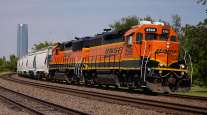Senior Reporter
Railroads Approaching Positive Train Control Full Implementation, FRA Says

[Stay on top of transportation news: Get TTNews in your inbox.]
The automatic braking system Congress is mandating for the country’s railroads is almost implemented on the route miles required by law, according to federal regulators’ most recent update.
On Nov. 18, the Federal Railroad Administration announced the positive train control technology, or PTC, is active or in advanced field testing on 57,314 route miles of the nearly 57,537 route miles subject to the requirement, based on data compiled as of Sept. 30.
The technology had been activated on an additional 468 miles during the third quarter of reporting. Approximately 223 required route miles remain to be activated, according to FRA.
Railroads also indicated to have made gains toward achieving interoperability testing, as well as meeting interoperability requirements.

According to Shelley Dellinger of Cargo Transporters and Alphonso Lewis, ATA’s Road Team Captain and YRC Freight driver, diversity in recruitment methods is essential. Hear a snippet, above, and get the full program by going to RoadSigns.TTNews.com.
“Full implementation of PTC is in sight, owing to everyone’s unparalleled cooperation and determination,” FRA Administrator Ronald Batory said in a statement Nov. 18. Congressional policymakers gave bipartisan backing to directing railroads to implement PTC systems by the end of this year.
The mandate is a two-year extension of Congress’ initial deadline.
Batory continued, “I’m incredibly proud of the intensive collaborations we have forged. Once complete, railroads, rail workers and rail passengers will all benefit from this transformational accomplishment in railroad safety.”
The agency said PTC systems are governing across the operations on the main lines owned or controlled by Class I freight railroads, and freight host railroads.
Ian Jefferies, president and CEO of the Association of American Railroads, confirmed for federal policymakers the freight rail industry’s work on PTC. Class I freight railroads include Norfolk Southern combined railroad subsidiaries, BNSF Railway, CSX Transportation, Kansas City Southern Railway, Soo Line Railroad, Grand Trunk Corp. and Union Pacific Railroad.
“I’m proud to say that each Class I freight railroad has 100% of required PTC route-miles in operation, 100% of required PTC-related hardware installed, 100% of their PTC-related spectrum in place, and 100% of required employee training completed,” Jefferies told the House Transportation and Infrastructure Committee this month. He added, “They are continuing to work to ensure full interoperability by the end of this year.”
The railroad agency, however, noted that New Jersey Transit is at risk of potentially not implementing the technology on its required main lines by the Dec. 31 deadline. As of Sept. 30, New Jersey Transit reported its PTC system was on advanced field testing status on about half of its 375.9 PTC-mandated route miles. FRA emphasized it continues to provide resources and technical assistance to New Jersey Transit.
On the PTC matter, the agency noted it held nine major informational sessions, and dozens of meetings with host and tenant railroads, suppliers, vendors and associations.
Additionally, the U.S. Department of Transportation has provided approximately $3.4 billion in grants and loans meant to assist railroads with PTC. The department has explained PTC technology is meant to help prevent train-to-train collisions, overspeed derailments and movement of trains through a switch in the wrong position. PTC also is meant to assist with the prevention of train incursions into established work zones.
The independent National Transportation Safety Board highlighted the need for implementing PTC in its “Most Wanted List” of priorities for policymakers.
Want more news? Listen to today's daily briefing:
Subscribe: Apple Podcasts | Spotify | Amazon Alexa | Google Assistant | More




